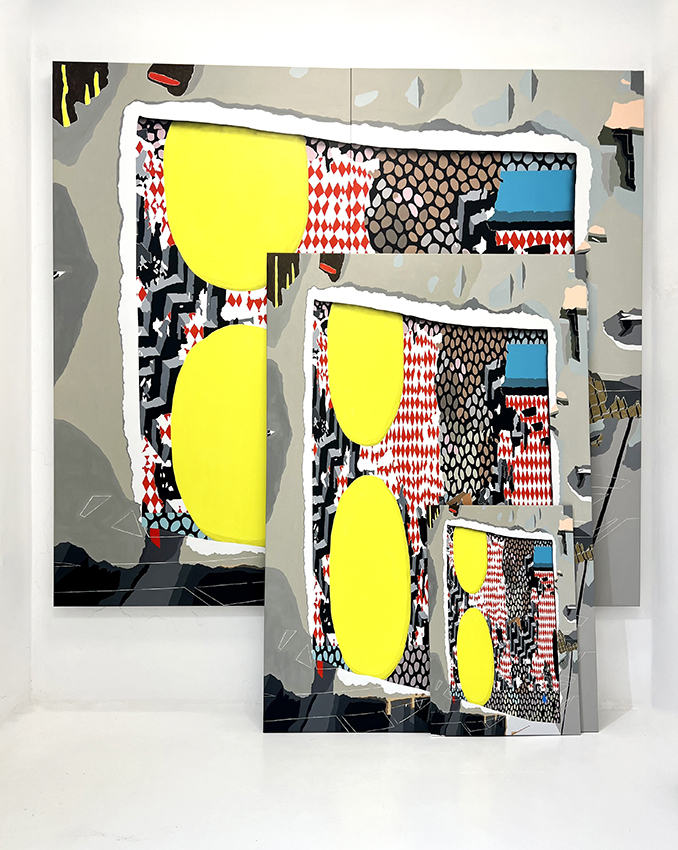
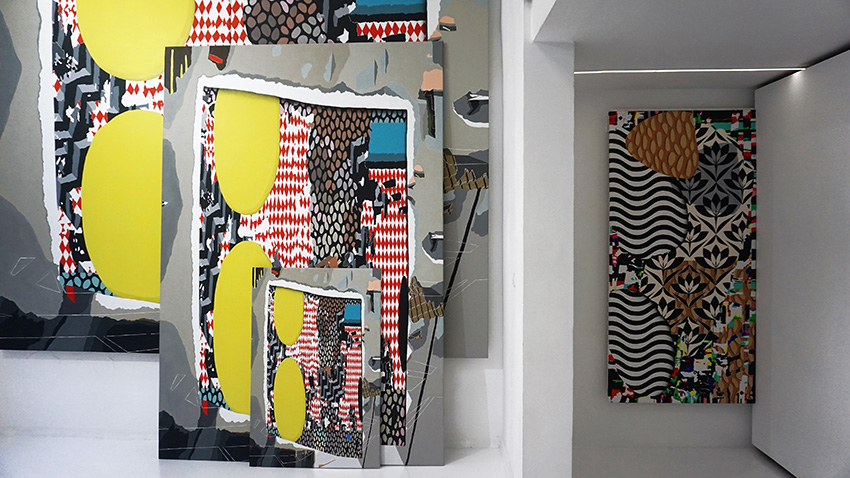
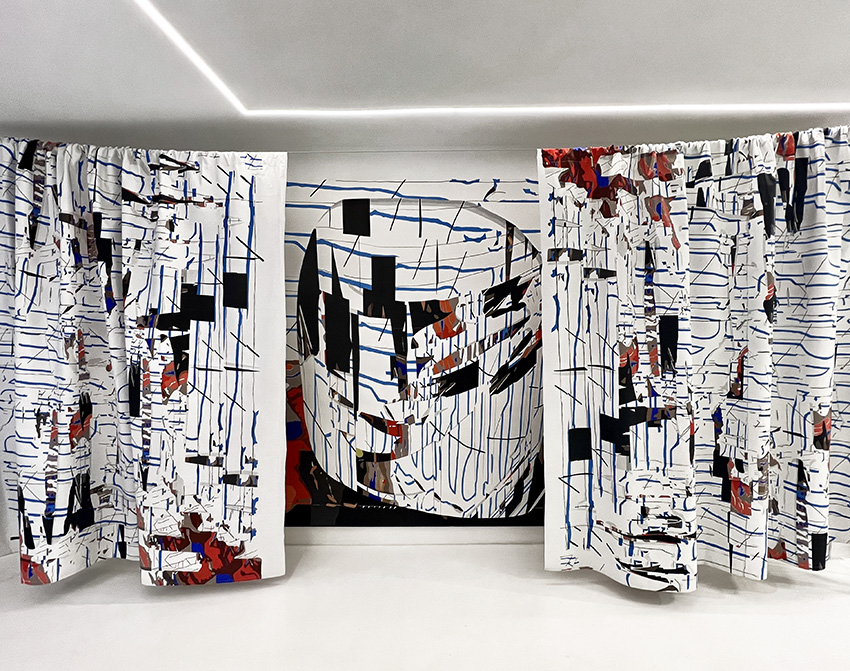
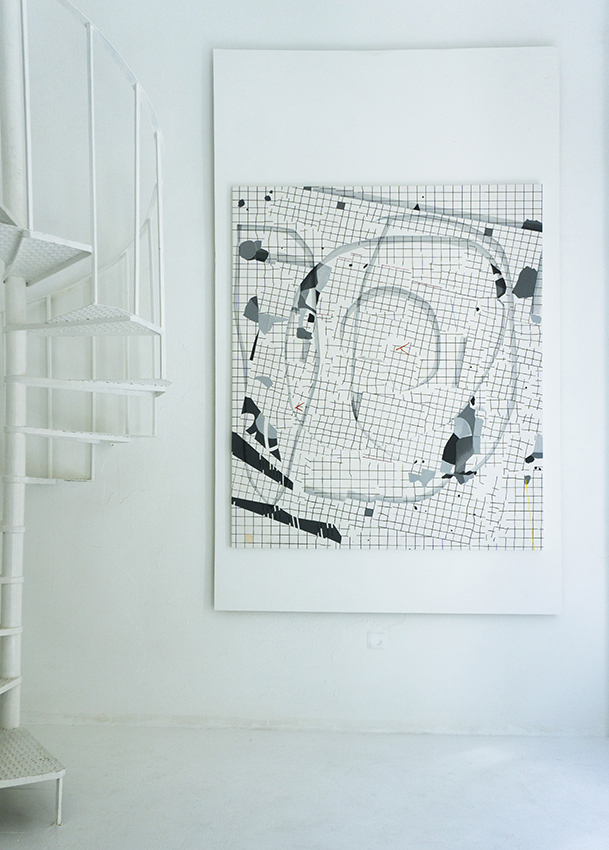
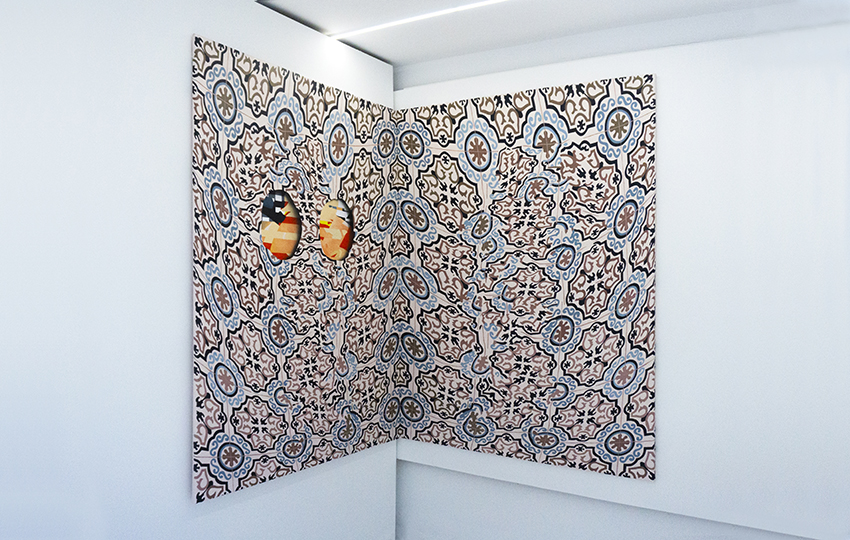
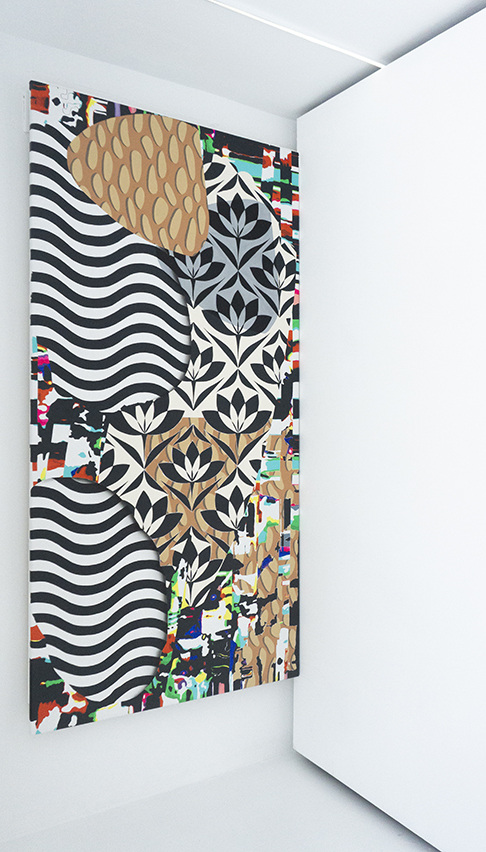
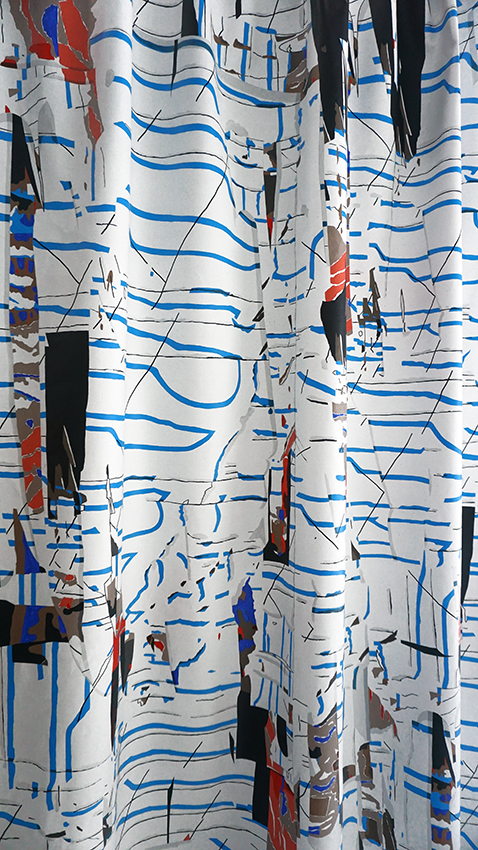
LA VERSIÓN PRIMERA ERA DE OTRO / JORGE LÓPEZ GALERIA / 2023
Being that the painting (or at least the one that uses its own critical root as a canvas, that is, the one that acts based on its tautology), has not managed, despite its attempts, to move or distance itself from the established paradigms during the modern project. Volkan Diyaroglu (Istanbul, 1982) starts from that same assimilation to propose an exercise in representing his own pictorial mechanism. We have to say, therefore, that Diyaroglu paints exactly what he paints, so that, in Heideggerian terms, everything is clear to one’s own eyes.
In this sense, we understand that contemporary pictorial practice, in any case, remains updated from the evolution of its own genealogy. It is as a result of this approximation that the aesthetic reforms, the updated symbolic codes and the own brands of contemporary visuality arise. Based on Volkan’s work, we can propose a development of this method of representation, a legacy of late-modern painting and its consequent crisis on the conception of visuality. On the occasion of the exhibition The First Version Was From Another (2023), at Jorge López Gallery, Diyaroglu presents a set of works that open up three different fronts, all of them characterized by the mutations of the representation depending on the gaze that activates the painting.
The first of these fronts has to do with the multiplication of images in the ideal of their repetition, essential to trace the tangent that crosses the thought of three of the great postmodern authors -Deleuze and his Difference and Repetition (1968), the reflection that Foucault does as a result of this in Theatrum Philosoficum (1970) and the originality of repetition posed by Derrida in Writing and Difference (1967)-. When Diyaroglu reflects on the eternal modern question as to what the image is, it is essential to understand it from an articulation in terms of its discontinuities. When we face The big other (2023), the state of its mens momentanea (momentaneous mind) alters the very notion of its visuality, giving rise to a change in its own contemplation as an image that repeats itself. The image, therefore, would resolve its difference based on the evidence of its own repetition. Perhaps for this reason, Diyaroglu alludes to the very tautology of the represented image to clarify what would be the signifiers that cross it. If you ask him about the margins of representation of him, he will tell you that his paintings are hyper-realistic images of those same paintings. His images are assumptions of the natural.
On the second of these fronts, Diyaroglu is going to mark a genealogical interest in the ways of looking at painting. In contemporary development, the meaning and its frameworks of social truth would constitute new subjectivities, suggested by the hegemonies of knowledge and culture. Therefore, it is not surprising that Diyaroglu, faced with the paradigm of the visual image, makes an allusion, in his language, to looking through the screens. The essence of these screens, as a focus of repetitions, is the product in which a series of systems converge, going through the microchip, the military development of the Internet, television, satellite, the telephone line or the telegraph, lead us to a radical basis argued in the dual perspective of the windows.
Diyaroglu’s window, Selfportrait (2023) and Lost horizon (2023), is a two-way portal, in which the production of the visual resource looks while being looked at. This idea of sale dismantles, in the circuit of hyper-communication and digital surveillance, the essence of the artwork as an object, to question whether, in the being-image of the artwork, there is the occasion of its very visualization. The window, understood as a history of Western art itself, at least from approaches such as those of Marx Wartofsky [See: Sight, Symbol and Society (1981)], describes, while presenting itself, the reality of its own mirror image. The crystal-image, argued by Deleuze from his reflection on cinema, acquires a new meaning, and this could be elucidated from Watch 1 (2023) and Watch 2 (2023), when the optical image and its virtual reflection are crystallized not in its imaginary level, but in the exchange and consequent update of the perception of that image by the one who looks at it. In some way, the mirror would be represented by the mirror itself, and we are the ones who are in the middle, looking sideways at both ends of the representation.
This crystallization of the virtual image, contemplated through the historiographical window of representation, opens the third stage that Diyaroglu faces in this exhibition. It remains in the interest of the artist to wonder what is the job of the painter in the ellipse of representation from digital neoliberalism, forcing voluntary submission to the doctrine of the image. The image contained in Diyaroglu’s canvases is the representation of a disembodied voice. At the same time, contemplating it makes us participate in certain silences that are omitted in our constant search for information and meaning, accelerated by the digital paradigm that we are so tired of criticizing, but so fundamental to structuring our knowledge.
Somehow, Diyaroglu’s painting, within its own genealogy, once again is asking us once againfrom where we have to look at it. This position, far from revealing a haptic approximation to its form, leads us to elaborate a perspective marked by our knowledge of visualization. We can get as close as we want trying to find a falsifying narrative in the image, surely Diyaroglu has taken care of the detail and in the repetition exercise he has repeated the mistake. We could also get as far away as the gallery setting allows us to identify the constellation and material exchange between the pieces that make up the exhibition. But, from this text, we dare to advise that we accept the invitation that is offered to us to elaborate resources to look “through” the framework of representation and with this, gain access to the original space of Diyaroglu’s images.
Álvaro Porras Soriano
ESP
Dejándolo claro, la pintura (o al menos aquella que usa de lienzo su propia raíz crítica, es decir, la que actúa en función de su tautología), no ha conseguido, a pesar de sus intentos, ni desplazarse ni alejarse de los paradigmas instaurados durante el proyecto moderno. Volkan Diyaroglu (Estambul, 1982) parte de esa misma asimilación para plantear un ejercicio de representación de su propio mecanismo pictórico. Tenemos que decir, por tanto, que Diyaroglu, pinta exactamente lo que pinta, para que, en terminos heideggerianos, todo sea patente a los propios ojos.
En este sentido, entendemos que la práctica pictórica contemporánea, en todo caso, queda actualizada desde el devenir de su propia genealogía. Es a raíz de esta aproximación que surgen las reformas estéticas, los códigos simbólicos actualizados y las marcas propias de la visualidad contemporánea. A partir de la obra de Volkan, podemos proponer un desarrollo de este método de representación, herencia de la pintura tardomoderna y su consecuente crisis sobre la concepción de la visualidad. Con motivo de la muestra La versión primera era de otro (2023), en Jorge López Galería, Diyaroglu presenta un conjunto de obras que abren tres frentes distintos, caracterizados, todos ellos, por las mutaciones de la representación en función de la mirada que activa la pintura.
El primero de esos frentes tiene que ver con la multiplicación de las imágenes en el ideal de su repetición, fundamental para trazar la tangente que cruza el pensamiento de tres de los grandes autores posmodernos -Deleuze y su Diferencia y repetición (1968), la reflexión que a raíz de ello hace Foucault en el Theatrum Philosoficum (1970) y la originalidad de la repetición planteada por Derrida en La escritura y la diferencia(1967)-. Cuando Diyaroglu reflexiona sobre la eterna pregunta moderna en tanto qué es la imagen, es indispensable comprenderlo a partir de una articulación en cuanto a sus discontinuidades. Cuando nos enfrentamos a The big other (2023), el estado de su mens momentánea altera la propia noción de su visualidad, dando pie a un cambio en su propia contemplación como una imagen que se repite sobre sí misma. La imagen, por tanto, resolvería su diferencia según la evidencia de su propia repetición. Quizás por ello, Diyaroglu alude a la propia tautología de la imagen representada para esclarecer cuales serían los significantes que la atraviesan. Si le preguntas por sus márgenes de representación, él te dirá que sus cuadros son imágenes hiperrealistas de esos mismos cuadros. Sus imágenes son, entonces, asunciones de lo natural.
En el segundo de esos frentes, Diyaroglu va a marcar un interés genealógico sobre las maneras de mirar la pintura. En el devenir contemporáneo, el significado y sus marcos de verdad social constituirían nuevas subjetividades, sugestionadas por las hegemonías del conocimiento y la cultura. Por tanto, no es de extrañar que Diyaroglu, ante el paradigma de la imagen visual, haga una alusión, en su discurso, a la mirada a través de las pantallas. La esencia de esas pantallas, en tanto que foco de repeticiones, es el producto en el que convergen una serie de sistemas que, pasando por el microchip, el desarrollo militar de internet, la televisión, el satélite, la línea telefónica o el telégrafo, nos conducen a una base radical argumentada en la perspectiva dual de las ventanas. La ventana de Diyaroglu, Selfportrait (2023) y Lost horizon (2023), es un portal de dos direcciones, en la que la producción del recurso visual mira mientras es mirado. Esta idea de venta desmantela, en el circuito de la hiper-comunicación y la vigilancia digital, la esencia de la obra como objeto, para cuestionar si, en el ser-imagen de la obra, está el acontecimiento de su misma visualización. La ventana, entendida como una historia del propio arte occidental, al menos desde planteamientos como los de Marx Wartofsky [Ver: Sight, Symbol and Society (1981)], describe, mientras se presenta a sí misma, la realidad de su propia imagen especular. La imagen-cristal, argumentada por Deleuze a partir de su reflexión sobre el cine, adquiere una nueva significación, y así podría elucidarse de Watch 1 (2023) y Watch 2 (2023), cuando la imagen óptica y su reflejo virtual quedan cristalizados no en su plano imaginario, sino en el intercambio y consecuente actualización de la percepción de esa imagen por parte de quien la mira. De alguna forma, el espejo quedaría representado por el propio espejo, y somos nosotros quienes estamos en el punto intermedio, mirando de reojo ambos extremos de la representación.
Esta cristalización de la imagen virtual, contemplada a través de la historiográfica ventana de la representación, abre el tercer estadio al que Diyaroglu se enfrenta en esta exposición. Queda en el interés del artista preguntarse cuál es la labor del pintor en la elipse de la representación desde el neoliberalismo digital, forzador del sometimiento voluntario a la doctrina de la imagen. La imagen contenida en los lienzos de Diyaroglu es la presentación de una voz sin cuerpo. A su vez, su contemplación nos hace participes de ciertos silencios que quedan omitidos en nuestra búsqueda de información y sentido constantes, acelerados por el paradigma digital que tan cansados estamos de criticar, pero tan fundamentales se nos hacen para estructurar nuestro conocimiento.
De alguna manera, la pintura de Diyaroglu, dentro de su propia genealogía, vuelve a preguntarnos desde dónde tenemos que mirarla. Esta posición, lejos de revelarnos una aproximación háptica a su forma, nos lleva a elaborar una perspectiva marcada por nuestro conocimiento de la visualización. Podemos acercarnos cuanto queramos intentando hallar una narración falsificante en la imagen, seguramente Diyaroglu haya cuidado el detalle y en su ejercicio de repetición haya repetido el fallo. También pudiéramos alejarnos todo lo que el escenario de la galería nos permite para identificar la constelación y el intercambio matérico entre las piezas que componen la exposición. Pero, desde este texto, nos atrevemos a aconsejar que aceptemos la invitación que se nos ofrece a elaborar recursos para mirar «a través del» marco de representación y con ello lograr acceder al espacio original de las imágenes de Diyaroglu.
Álvaro Porras Soriano
+information: https://jorgelopezgaleria.com
*Zrealizowano przy pomocy funduszu stypendialnego ze środków finansowych budżetu Miasta Gorzowa Wielkopolskiego.

